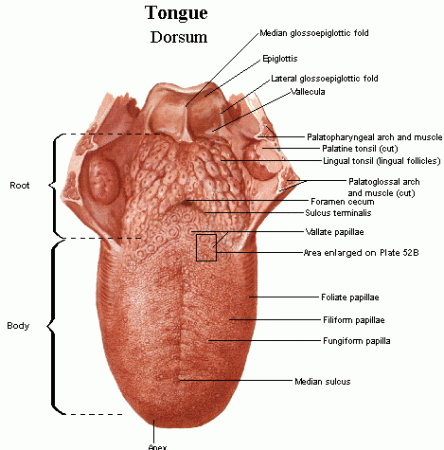The tongue
- Category: Digestive system
- Views: 23189
The tongue has a conical shape. The tongue - unpaired body. The tongue is located in the oral cavity.
The outer structure of the tongue
Tongue is divided:
- root of the tongue (radix linguae);
- body of the tongue (corpus linguae);
- apex (tip) of the tongue (apex linguae);
- the back of the tongue (dorsum linguae);
- the lower surface of the tongue (facies inferior linguae).
On the back of the tongue is a blind hole (foramen cecum linguae). From the blind hole aside and ahead goes steam frontier furrow. This furrow divides the tongue into pre-furrow part and after-furrow part.
The internal structure of the tongue
The tongue consists of muscles covered with mucous membrane. The muscles of the tongue are divided into skeletal and own. Skeletal muscle:
- Awl-lingual muscle - starts from subulate process, shifts the tongue up and back;
- Sublingual-lingual muscle - starts from the hyoid bone, the tongue shifts back and down; aside;
- Chin-lingual muscle - starts from chin spine, shifts the tongue ahead.
Own muscles of the tongue:
- The upper longitudinal muscle - shifts the tongue back, shortens it;
- The lower longitudinal muscle - shifts the tongue back, shortens it;
- Transverse muscle of the tongue - continuation of palate-lingual muscles, reduces the transverse dimension of the tongue (tongue twists a tube);
- Vertical muscle of the tongue - continuation of chin-lingual muscle, with it the tongue shifts ahead and making it more flat. Features of the mucous membrane of the tongue:
- Flat multilayered epithelium;
- Tongue glands secrete saliva;
- Lymphoid tissue represented by lingual tonsil, which is located at the root of the tongue;
- Mucosa in the transition from the tongue to the bottom of the oral cavity forms paired hyoid crease and unpaired crease - bridle of the tongue.
Development of the tongue
The tongue develops from several germs:
- muscles of the tongue develop from the occipital myotomes (dorsal mesoderm);
- Body and tip of the tongue develop from two lateral tubercles of the tongue (processes of 1st gill arch). Trace of accretion of paired germ remains in the form of fibrous septum of the tongue;
- Back of the tongue develops from unpaired tubercle between I and II gill arches;
- The root of the tongue develops from the thickening of the mucosa, derivative of III-IV gill arches.
Accretion trace of pre- and after furrows of the tongue remains in the form of border furrow. Blind hole - is residue of median diverticulum, from which develops isthmus of the thyroid gland.
Anomalies of the tongue:
- Absent tongue;
- Underdeveloped tongue;
- Excessively developed tongue;
- Forked tongue - occurs, if lateral tubercles tongue do not grow together;
- Double tongue (lingua duplex) - occurs when development of unpaired tubercle is incorrect;
- Immovable (pryroschen) tongue, happens when bridle of the tongue is short;
- Folded tongue.
Functions of the tongue:
- Digestion (food mechanical processing, forming of food lump, swallowing);
- Tongue is the organ of taste;
- Tongue is the organ of language.
